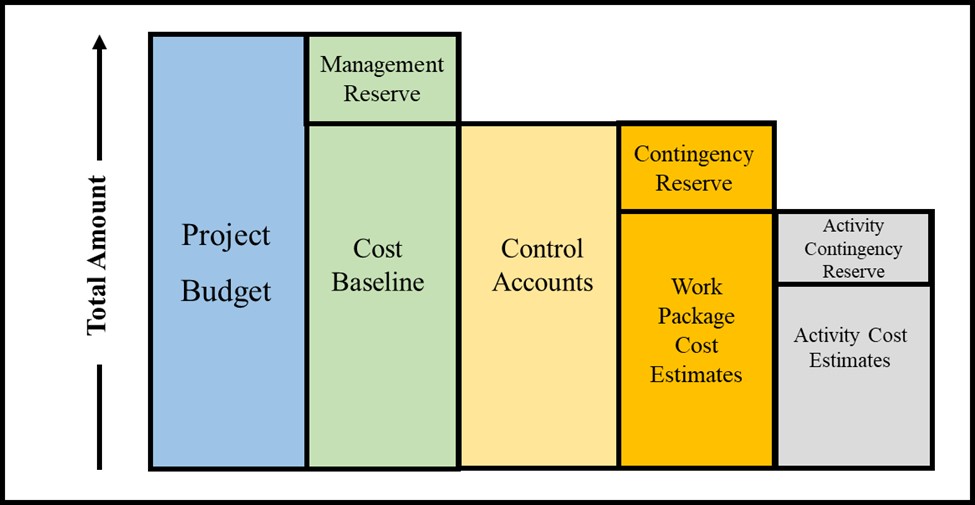Chapter 9. Budget and Procurement
9.4 Establishing the Project Budget
Once the cost of each activity is estimated, it is possible to determine how much money is needed for each activity and component, and the whole project. The process of subtotaling costs by category or activity is called cost aggregation. PMBOK Guide Sixth Edition defines this process as “Determine Budget” which is a process of aggregating the estimated costs of individual activities or work packages to establish an authorized cost baseline[1]. This baseline is a time-phased budget that can be used to measure and monitor cost performance after it has been approved by the key project stakeholders. The aggregated budget is integrated with the project schedule in order to produce the time-phased budget. Costs are associated with tasks, and since each task has a start date and a duration period, it is possible to calculate how much money will be spent by any particular date during the project. Recognizing that all the money required to deliver the project is not needed upfront, allows the cash flow needs of the project to be effectively managed. For smaller organizations facing cash flow challenges, this can result in significant savings as the money required to pay for resources can be transferred to the project account shortly before it is needed.
Figure 9.1 illustrates the project budget components. While estimating the costs (see section 9.3), the project team should take into account the uncertainties that may affect the costs. This requires a reserve analysis which is conducted in line with risk management (See Chapter 10). Therefore, cost estimates are accompanied by contingency reserves for each activity and work package, if applicable. As can be seen in Figure 9.1, contingency reserve is included within the cost baseline. Therefore, these reserves must be incorporated into the baseline that ensures the monitoring and controlling of the project cost performance.

Adapted from PMBOK Guide Sixth Edition
Let’s elaborate more on the reserve analysis. Contingency reserves are determined according to the risks that can be identified by the project team. Thus, they are called “known-unknowns”. In our m-commerce project, our team identified a risk regarding the shortage of software developers. The demand for developers increased recently since the demand for online games and mobile apps has been on a sharp rise after the emergence of the COVID-19 pandemic. Therefore, we may experience a shortage of developers in the market. This risk can directly affect the activities under “2. Analysis/App Requirements” and “4. Development”. Therefore, it would be appropriate to allocate contingency reserves to each affected activity. Unlike contingency reserve, management reserve is determined based on “unknown-unknowns” and applies to the whole budget. One obvious risk that emerged at the end of 2019 and has had a severe impact on all countries since March 2020 is the COVID-19 pandemic. This pandemic was an unknown-unknown for all the projects across the world.
The amount of a contingency reserve for each activity or a higher WBS level is determined after the risks and the strategies are identified and detailed (see Chapter 10). For instance, if an activity to test a website’s functions and security is estimated to cost $10,000, the project team can put an additional budget of $2,000 to ensure an effective response to the security gaps if occurs. Then, the cost baseline of this activity becomes $12,000 ($10,000 + $2,000). It can be adjusted when more information becomes available as time passes and activities are conducted and completed. It is also possible that new risks may emerge which has not been forecasted while the project management plans were being prepared. This is why project teams have regular meetings at which all the project components, issues, and risks are reviewed, which allows the team to take timely actions.
If we turn back to Table 9.3, we can see that the contingency reserves are not determined, therefore, the cost baseline includes only the resource costs. Let’s assume that the project team agreed on contingency reserves for three activities as shown in Table 9.5. Therefore, the cost baseline increases from $23,920 to $24,920.
Table 9.5: Cost Estimates and Contingency Reserves for “Scope” component
| WBS | Activity Name | Cost | Contingency Reserve | Cost Baseline |
| 1.1 | Clarify project purpose and determine project scope | $4,000.00 | $300.00 | $4,300.00 |
| 1.2 | Secure project sponsorship | $0.00 | $0.00 | $0.00 |
| 1.3 | Preparation of project charter | $7,920.00 | $0.00 | $7,920.00 |
| 1.3.1 | Develop high-level scope | $960.00 | $0.00 | $960.00 |
| 1.3.2 | Identify main resources and develop a high-level budget | $1,200.00 | $0.00 | $1,200.00 |
| 1.3.3 | Develop high-level schedule | $1,440.00 | $0.00 | $1,440.00 |
| 1.3.4 | Identify main resources and develop a high-level budget | $960.00 | $400.00 | $1,360.00 |
| 1.3.5 | Identify key stakeholders and project team member roles | $2,160.00 | $300.00 | $2,460.00 |
| 1.3.6 | Develop project approval requirements and project exit criteria | $1,200.00 | $0.00 | $1,200.00 |
| 1.4 | Approval of project charter by the sponsor | $0.00 | $0.00 | $0.00 |
| 1.5 | Secure core resources | $0.00 | $0.00 | $0.00 |
| 1.6 | Initiation stage complete | $0.00 | $0.00 | $0.00 |
| Project Manager’s Salary | $12,000.00 | $0.00 | $12,000.00 | |
| TOTAL COST OF SCOPE | $23,920.00 | 1,000.00 | $24,920.00 |
- Project Management Institute. (2017). A guide to the Project Management Body of Knowledge (PMBOK guide) (6th ed.). Project Management Institute. ↵

